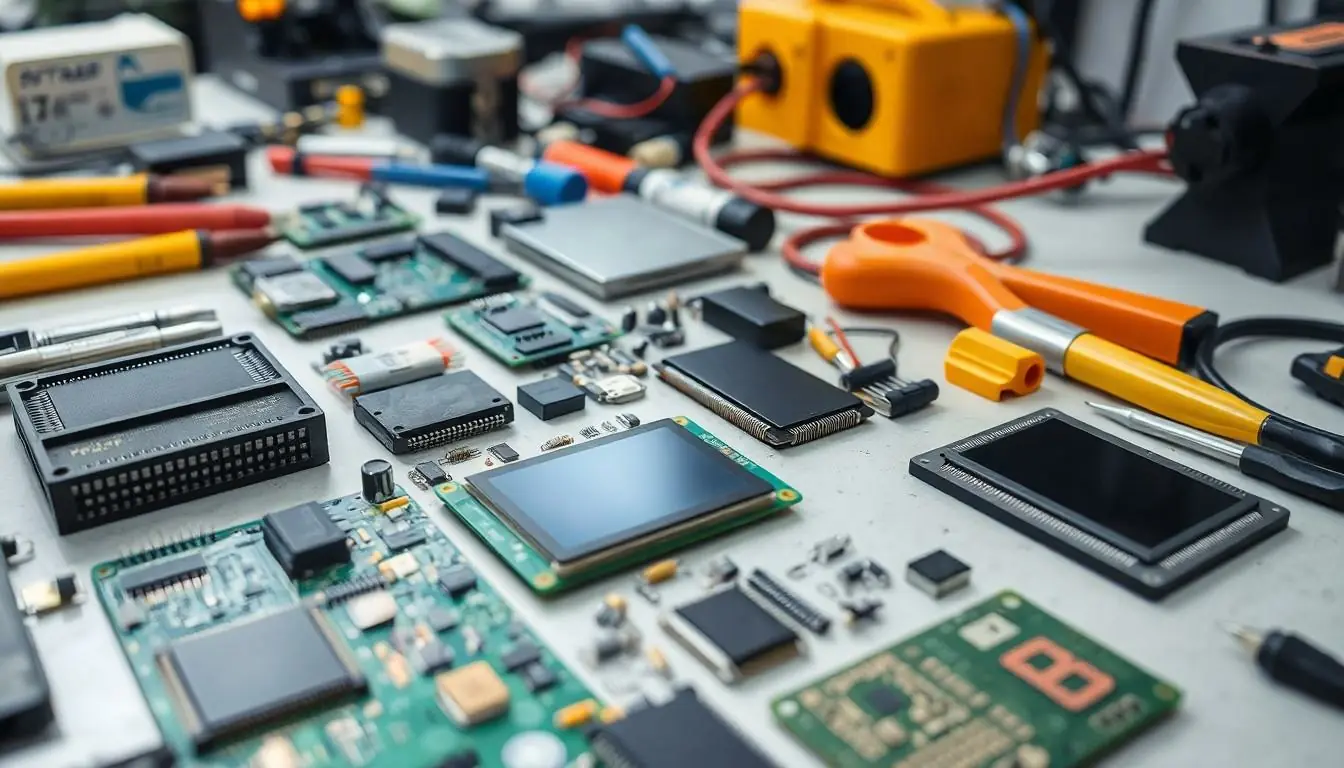Table of Contents
ToggleIn a world where gadgets seem to multiply faster than rabbits, consumer electronics manufacturing stands at the forefront of innovation. Picture this: one moment you’re struggling to find the perfect headphones, and the next, you’re bombarded with options that promise to make you feel like you’re at a live concert—without the sticky floors and overpriced drinks.
Overview of Consumer Electronics Manufacturing
Consumer electronics manufacturing encompasses the production of various gadgets, devices, and appliances designed for everyday use. This sector has transformed significantly due to advancements in technology and evolving consumer preferences. Increased competition drives manufacturers to innovate, leading to an ever-expanding range of products.
Headphones exemplify this rapid evolution. With each new model, companies integrate cutting-edge features such as noise cancellation, wireless connectivity, and customizable audio settings. The convenience of these advancements enhances user experiences, making products more appealing in a crowded market.
Market demands shape manufacturing strategies. Manufacturers focus on sustainability by adopting eco-friendly materials and efficient production techniques. Reducing waste and energy consumption not only lowers costs but also meets consumer expectations for environmentally responsible practices.
Globalization plays a crucial role in consumer electronics manufacturing. Companies often outsource production to countries with lower labor costs while maintaining strict quality control. This strategy creates a balance between affordability and high standards, ensuring products meet consumer needs worldwide.
Progress in automation influences production efficiency. Robotics and artificial intelligence streamline assembly lines, allowing manufacturers to produce large quantities of high-quality electronics. As a result, companies can respond quickly to market shifts and consumer trends.
Overall, the landscape of consumer electronics manufacturing is dynamic and responsive. Manufacturers continually adapt to technological advancements and market demands, ensuring a diverse array of products that enhance daily life.
Key Components in Consumer Electronics

Consumer electronics rely on several key components for functionality and performance. Understanding these components reveals how they contribute to the overall user experience.
Integrated Circuits
Integrated circuits serve as the brain of consumer electronics. These semiconductor devices combine multiple electronic components into a single chip, offering efficiency and compactness. They process information and control functions within devices like smartphones, laptops, and televisions. Variations include microcontrollers, digital signal processors, and memory chips. The rapid pace of innovation in integrated circuit design leads to increasingly powerful and energy-efficient devices.
Displays and Screens
Displays and screens play a crucial role in user interaction. Technologies such as LCD, OLED, and LED offer vibrant images and energy efficiency. Resolution, refresh rate, and screen size impact the visual experience significantly. Manufacturers prioritize high-quality displays to meet consumer demands for clearer visuals and better performance. Additionally, advancements in touch screen technologies enhance usability, making navigation intuitive across devices like tablets and smartphones.
Major Players in the Industry
Consumer electronics manufacturing features a competitive landscape dominated by established brands and emerging companies. Key market players influence product innovations and set trends through cutting-edge technologies.
Leading Manufacturers
Samsung Electronics stands out as a leading force, consistently delivering smartphones, televisions, and home appliances. Apple, renowned for its iPhones and MacBooks, leads in design and user experience. LG Electronics focuses on televisions and home appliances, integrating advanced technologies for improved performance. Sony contributes significantly with its gaming consoles, audio systems, and mobile devices. These manufacturers command a considerable share of the global market, shaping consumer preferences through their product offerings.
Emerging Companies
New players also play a vital role in shaping the consumer electronics landscape. Xiaomi, known for its affordability and innovation, has quickly risen to prominence with smart devices and smartphones. OnePlus appeals to tech-savvy consumers with high-performance smartphones at competitive prices. Additionally, Oppo prioritizes camera technology and design, catering to a growing demographic of photography enthusiasts. These emerging companies challenge established brands by focusing on unique features and budget-friendly options, further diversifying the market.
Challenges in Consumer Electronics Manufacturing
The landscape of consumer electronics manufacturing is fraught with challenges that impact efficiency and product quality. Addressing these issues is vital for maintaining competitiveness.
Supply Chain Issues
Supply chain disruptions significantly affect production timelines and costs. Delays in component deliveries, influenced by geopolitical tensions and natural disasters, often lead to product shortages. Manufacturers face increased costs as they seek alternative suppliers. Maintaining inventory levels becomes complex as fluctuating demand complicates forecasts. Considering just-in-time inventory strategies may not suffice amid global uncertainties. Companies often invest in supply chain management systems to enhance visibility and adaptability. These systems allow for better tracking of materials, reducing bottlenecks caused by unforeseen circumstances.
Technological Advancements
Technological advancements pose both a challenge and an opportunity for manufacturers. Rapid innovations require ongoing adaptation of production processes and methodologies. Staying ahead of competitors often demands significant investments in research and development. Emerging technologies like artificial intelligence and machine learning streamline operations and improve quality control. Implementing these advancements often requires specialized skills and training for the workforce. Budget constraints may limit smaller manufacturers from fully capitalizing on these technologies. However, those who successfully integrate the latest innovations can gain a competitive edge in product offerings and efficiency.
Future Trends in Consumer Electronics Manufacturing
Transformations in consumer electronics manufacturing continue with a strong emphasis on sustainability. Manufacturers increasingly integrate eco-friendly materials into their products, responding to heightened consumer awareness about environmental impacts. Demand for greener practices drives innovation in production techniques, leading to efficient and responsible manufacturing processes.
Advancements in technology shape future product offerings significantly. Devices are becoming smarter and more interconnected through the Internet of Things (IoT). This shift enhances the user experience by allowing seamless communication between devices, creating a more integrated ecosystem for consumers.
AI and machine learning play crucial roles in optimizing manufacturing processes. Enhanced production efficiency results from automating tasks, enabling manufacturers to respond quickly to market trends. New algorithms improve quality control, ensuring that products meet rigorous standards while minimizing waste.
Consumer preferences shift towards personalized experiences, prompting manufacturers to focus on customization. From tailored features in headphones to adjustable settings in smart home devices, brands are exploring ways to meet individual needs and enhance consumer satisfaction.
Emergence of 5G technology opens up new possibilities for rapid data exchange. Faster internet connectivity paves the way for innovative applications, increasing efficiency in smart devices. As this technology expands, consumer electronics will evolve, enabling enhanced functionalities and improved user experiences.
Global supply chain strategies are adapting to mitigate challenges. Companies invest in localizing production to reduce vulnerability to geopolitical risks and natural disasters. Strategic partnerships with suppliers enhance resilience, ensuring timely delivery and product availability.
Investment in research and development remains critical for staying competitive. Prioritizing innovation leads manufacturers to find ways to introduce cutting-edge technologies while refining existing products. As competition escalates, brands must continually evolve to meet consumer demands for quality and functionality.
The consumer electronics manufacturing landscape is evolving rapidly as technology advances and consumer preferences shift. Manufacturers are increasingly focused on innovation and sustainability to meet the growing demand for high-quality and eco-friendly products. The integration of smart technologies and enhanced connectivity is reshaping user experiences, while challenges like supply chain disruptions and the need for continuous adaptation remain.
As competition intensifies, both established brands and emerging companies are pushing the boundaries of what’s possible. The future of consumer electronics manufacturing promises exciting developments as companies embrace new technologies and prioritize consumer-centric solutions. This dynamic environment will continue to shape how consumers interact with their devices, ultimately driving the industry forward.



